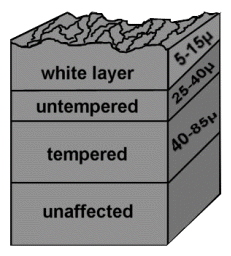| |
|
Javascript DHTML Drop Down Menu Powered by dhtml-menu-builder.com

Counters EDM "White" Layer effect
Electrical Discharge
Machining (EDM), while providing a rapid and relatively less expensive means
for producing die casting die inserts, at the same time sets up some very
high and detrimental surface stresses. These stresses if not completely and
properly removed, can accelerate thermal stress cracking.
Metal is removed by
a series of electrical spark discharges. The steel in the contact area melts
or vaporizes then solidifies on the surface of the cavity. Each spark erodes
a tiny bit of metal, leaving a small crater in the surface of the tool. This
leaves the immediate surface in a high residual tensile stress condition.
The topmost or recast "white"
layer is a brittle, hard layer prone to cracking. This is the material that
has melted and rapidly solidified. The white layer is densely infiltrated
with carbon and has a distinct separate structure to that of the parent
metal.
Below this layer is the heat affected zone that has been structurally
altered by the heat produced during EDM. This layer reaches the austenizing
temperature of the steel. The zone may contain re-hardened or hard, brittle
"untempered"
martensite formed during the rapid cooling from the austenizing temperature.
This can increase crack susceptibility since this microstructure stores
considerable strain energy that decomposes with heat.
After mandatory removal, by polishing, of the top "white cast" layer" it is
important to protect the next exposed layer.
MetaLLife
compressive stress removes the scratch stress risers created during
polishing and closes the cracks that have propagated below the recast
layer into the heat affected "untempered
martensite" zone.
This
restores the desired residual compressive stress benefits to the tool.
Related Topics
> - Welded Area Protection
|
|
|
|

EDM layer zones*
white layer - 5-15 microns - crack prone
untempered - 25-40 microns - crack prone
tempered - 40-85 microns
1 micron = 0.00003937"
*Depth of zones is dependent on the spark
density, volts, and amps of EDM equipment
|
|
|
